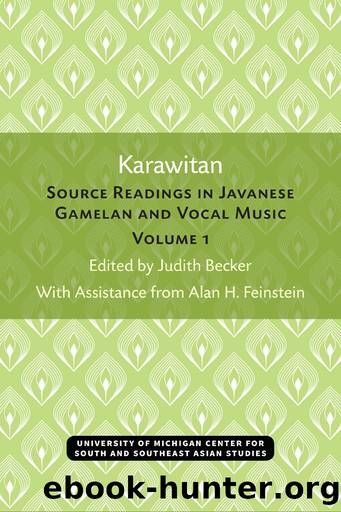Karawitan Source Readings in Javanese Gamelan and Vocal Music: Volume 1 by Judith Becker

Author:Judith Becker
Language: eng
Format: epub
Publisher: University of Michigan Center for South and Southeast Asian Studies
Published: 2020-02-15T00:00:00+00:00
It has been pointed out that gendhing are composed with equal metrical units marked by the strokes of various gongs; the underlying feeling of a gendhing is based on the smoothly flowing quality of the inner melody, as discussed in chapter II. The marriage between the metrical units (with their gong markers) and the inner melody typifies the musical style of Javanese gamelan music.
In this section, the relationship between inner melody and the various gongs that mark gendhing forms will be discussed. The players of the kenong and kempul usually play tones that coincide with the tones of the inner melody of the gendhing. This kenong or kempul technique is called kenong mbalung or kempul mbalung, since kenong or kempul strokes also coincide with tones of the balungan. However, sometimes the kenong or kempul tone anticipates the approaching tone of the inner melody. This technique is called kenong plèsèdan or kempul plèsèdan. âPlèsèdanâ literally means âslippery placeâ. Plèsèdan technique is an indication that the kenong or kempul player feels the smooth pull of the inner melody toward the tone that follows (see figures 45 and 46).
Figure 45. Example of Kenong Plèsèdan (Gendhing Onang-onang, laras pélog pathet nem, Excerpt)
Download
This site does not store any files on its server. We only index and link to content provided by other sites. Please contact the content providers to delete copyright contents if any and email us, we'll remove relevant links or contents immediately.
The Goal (Off-Campus #4) by Elle Kennedy(12433)
Kathy Andrews Collection by Kathy Andrews(10519)
Diary of a Player by Brad Paisley(6866)
What Does This Button Do? by Bruce Dickinson(5527)
Assassin’s Fate by Robin Hobb(5236)
Big Little Lies by Liane Moriarty(4880)
Pale Blue Dot by Carl Sagan(4001)
Sticky Fingers by Joe Hagan(3454)
The Heroin Diaries by Nikki Sixx(2931)
The Death of the Heart by Elizabeth Bowen(2901)
Beneath These Shadows by Meghan March(2718)
The Help by Kathryn Stockett(2703)
Confessions of a Video Vixen by Karrine Steffans(2674)
How Music Works by David Byrne(2525)
Jam by Jam (epub)(2489)
Harry Potter 4 - Harry Potter and The Goblet of Fire by J.K.Rowling(2416)
Strange Fascination: David Bowie: The Definitive Story by David Buckley(2367)
Petty: The Biography by Warren Zanes(2237)
Darker Than the Deepest Sea by Trevor Dann(2206)
